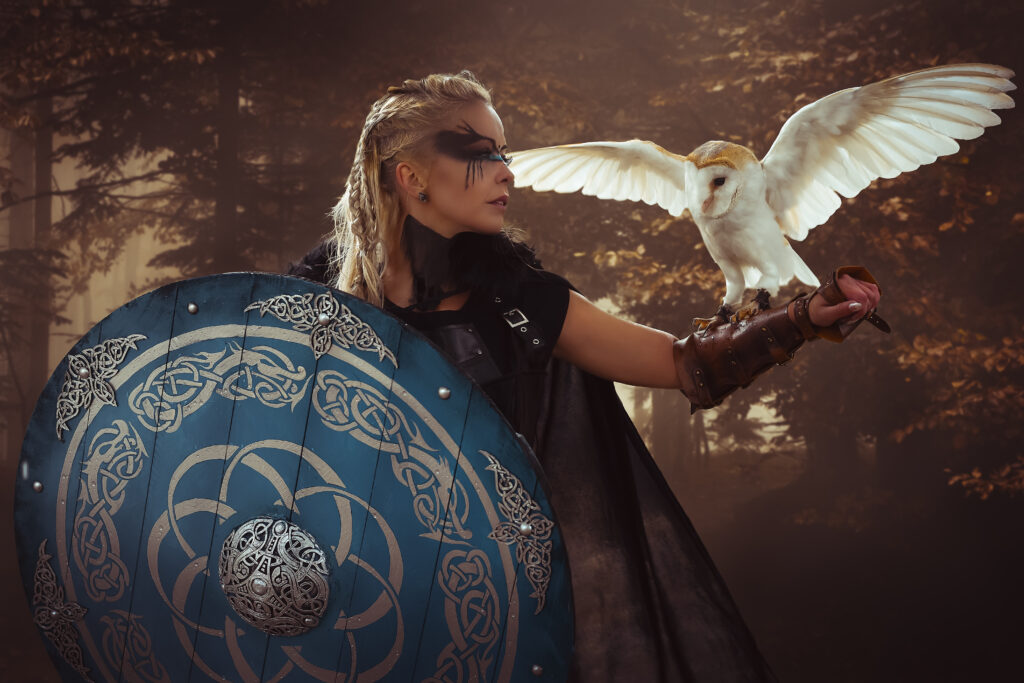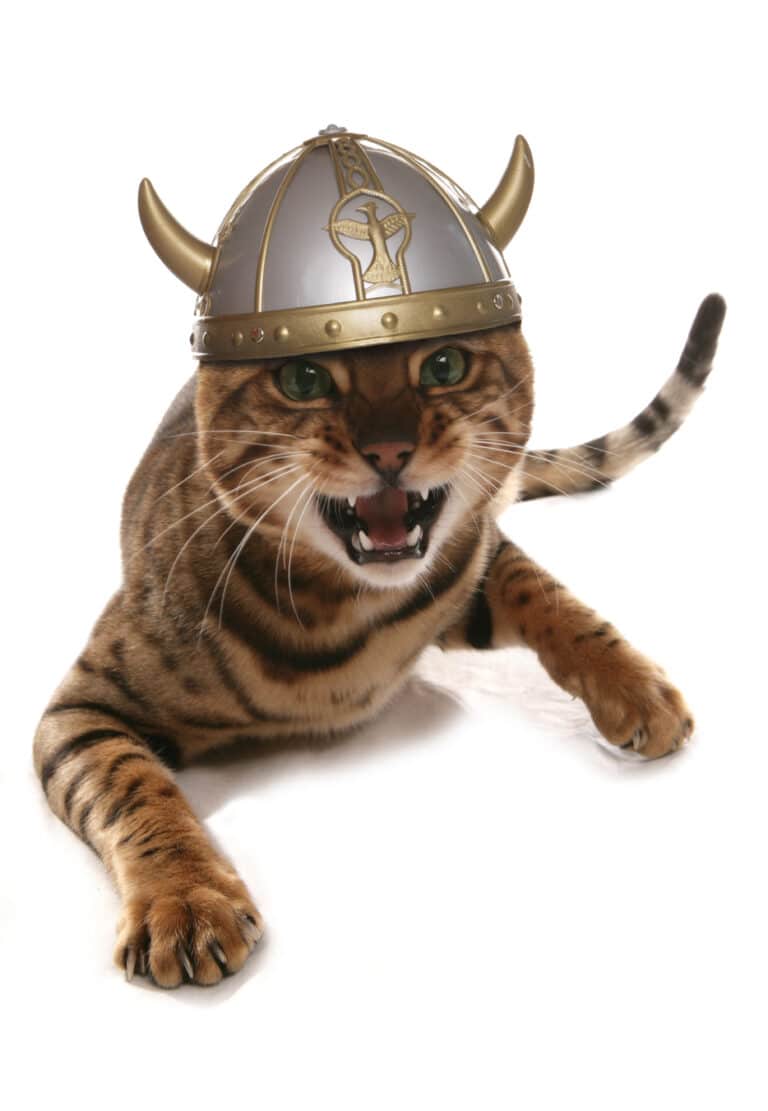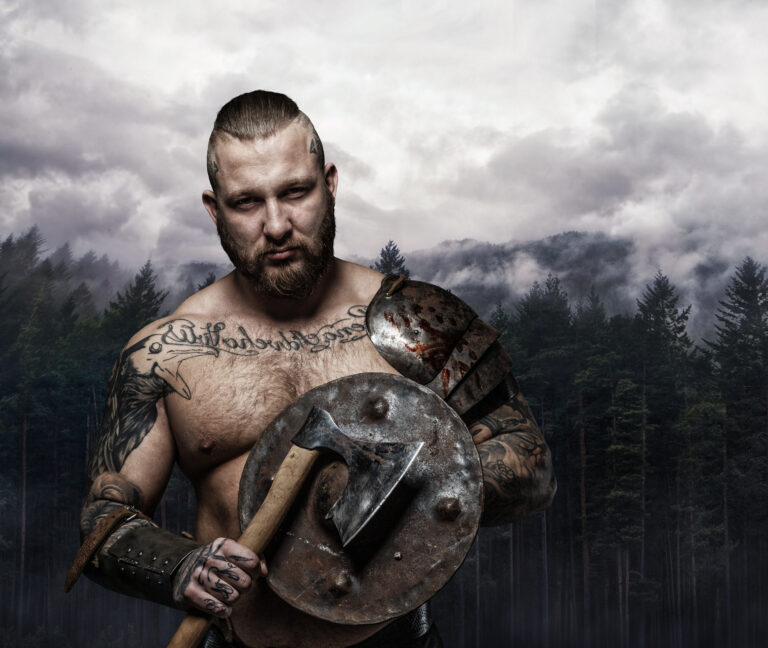Did the Vikings Have Tattoos: Iconography and Permanency

This is a pretty common question. We get so much of our knowledge from media sources, and sometimes those sources are misleading. Loads of ancient tribes (do we even refer to the Norsemen as Ancient?) had tattoos. Therefore, it isn’t unreasonable to believe Vikings may have had tattoos. The only problem is, of course, that Vikings lived so long ago that they basically leave us with only their bones to examine. So how would we figure out if the Vikings did have tattoos? Well, in these cases you would look for references in literature, perhaps iconography that depicted tattoos, or perhaps the tools of the trade. There are extremely rare samples found in graves where the skin has been preserved, but to my knowledge none of those finds contained tattoos.
They May Have Had Other Means of Marking Their Bodies
Aside from tattoos, some tribes also utilized scarification as a means of permanently marking the body. There are also those who modified their bodies in some way that was linked to culture, ritual, or rite of passage. I will start by discussing the theories behind why we think the Vikings might have had tattoos, but I will leave you with one example of something they actually did that we have proof of, and would qualify as a form of body modification.
Viking Tattoos Described in Literature: Risala of Ibn Fadlan

There are basically only two literary sources that float the idea of Vikings having tattoos. The first comes from the 10th century Arab scholar Ibn Fadlan. Now, let me take a minute to discuss him, because he causes some purposely misleading confusion when it comes to research.
So Ibn Fadlan was indeed real. However, he is used as a source in the book “Eaters of the Dead” by Michael Creighton. Subsequently, this book is used as a source for the movie “The 13th Warrior”. Both tell the story of his travels, and his encounters with what he dubbed “the Rusiyyah”, or “the Rus” as they were sometimes referred to as well.
The book does rely on the actual historical manuscripts, but in the afterword of the book Michael Creighton explains that he used that for the first few chapters, and then went completely rough. So a lot of that book is fabricated. Therefore a lot of the movie that followed was completely fabricated, even though both are linked to a historical source.
Tattooed from Their Neck to Their Fingertips

Well, the first issue with this description is that “the Rus” were not in Scandinavia. They were thought to be descendants of the Norse people but living in what we now call Russia. In his text, Ibn Fadlan describes the Rus as having perfect bodies. They are said to wear cloaks that cover half their torso so that one arm remains uncovered and free. So far this would line up with the image of the Vikings being powerful men, with strong physics who need a free arm for all the fighting they do.
He says the men had tattoos from their necks to the tips of their fingers. He doesn’t mention the women having tattoos. This would indicate that the tattoos were then perhaps a sign of a warrior. Plenty of tribes have some kind of body modification tied to rites of passage, like age, or a first kill. These things typical align with values of masculinity, and therefore it would make sense for the Vikings to have SOME indication that they were a great warrior, versus a feeble farmer who was unable to take part in battle.
Tattoos Were Likely Made Using Wood Ash
Ibn Fadlan described the tattoos as being dark green in color and comprised of iconography that does line up with Norse mythology. He described trees and symbols. We of course know that the Vikings (particularly during the pagan period) believed in Yggdrasil, the Tree of Life. It is the first tree that comes to mind when hearing of the symbols tattooed on Vikings. “Symbols” might be an over simplification of runes of the Elder Futhark. A foreign traveller wouldn’t be expected to know this symbology, or what they might have said, so describing them as symbols makes sense. I kind of theorized that “symbols” found on a carved flagstone in Oak Island, Nova Scotia could have been misunderstood in a similar fashion. To read more about that, check out this post on the Vikings in Oak Island.
Scholars believe that tattoos would have actually been blue, not green, particularly if they were made using wood ash.
Ibnrahim Ibn Yacoub Al-Tartushi Also Described Seeing Tattoos
Another traveller who spoke about tattoos on the Vikings was a Muslim representative travelling through Denmark. He mentioned that he was surprised that Viking women could divorce (go check out a post on Vikings Laws for more info about structured society), and that both men and women wore makeup on their eyes.

Both travellers used an Arabic word for “tattoo” that is also used to describe geometric mosque decorations. These are said to be similar in design to Viking knotwork.
Norse Literature Does Not Mention Tattoos
Those early sources certainly went a long way in influencing our opinion about the dress, demeanor, style, and physique of the Vikings. It is important to note that none of the saga literature, Prose Edda or Poetic Edda mention tattoos at all.

To me, this does not entirely rule them out. We have to remember that much of this work was created in the 13th century. This was under the rule of a new Christian kingdom. We have actually lost a great deal of information, particularly about the pre-Christian period in Scandinavia. So if tattoos were tied to pagan ritual or culture in the pre-Christian period, it might just not be remembered. This literature was recorded 300 years later. We lack a great deal of understanding about pagan ritual. Their practice, and the role of Pagan gods in everyday life was not recorded. Therefore, their absence from the literature is not enough to convince me that tattoos were not important to the Vikings.
Archeological Evidence of Viking Tattoos
A lot of sources will claim that there have been no Viking Age burials uncovered that still have their skin intact. This is not actually true. When I lived in Iceland I visited the National Museum during the time they had the “Bundled Up in Blue” exhibit. This was a 10th century burial of a Viking woman who was remarkable preserved. Small skins samples survived. Particularly of her lower jaw because it was leaning against her bronze brooch, which preserved the skin.
Now it’s not a man, and not an area of the body even described by Ibn Fadlan as being tattooed. However, I just wanted to add that there are circumstances where skin is found intact. This means there is still hope for a Viking Era male warrior to be found with some skin intact. This could lend credence to the question of whether or not Vikings had tattoos.
Check out information on the exhibit here: Bundled Up In Blue.

Neighbouring Tribes Have Evidence of Tattoos
There have been burials unearthed that pre-exist the Viking Age and show evidence of tattoos. The Scythian’s, with whom the Vikings traded, were a neighbouring tribe. A Scythian Chieftan, buried circa 500 BCE, in what is now Serbia was preserved by permafrost. His remains show tattoos on his skin, and it is likely that Vikings would have learned of this technique. After all, they did trade with groups all-over modern-day Europe, the North, and as far as the Mediterranean.
There was also a Ukok Princess who was preserved with visible tattoos showing. So this means it might not be unheard of for Viking women to have had tattoos as well.
Finally the Saami people, who were known to have intermarried with the Vikings practiced tattooing. They inhabited modern day Finland, Sweden, and the Kola Peninsula.
It is likely that the Vikings were introduced to tattooing tools and techniques. Whether or not they chose to use this practice is something unproven at this point. It is unsupported by historical fact, or archeological finds.
They Did Permanently Make Their Bodies: Vikings Filed Their Teeth
I told you to hang on until the end so I could tell you about one way that the Vikings engaged in body modification. This is kind of a recent find. I remember being in University actually taking a course in my undergrad called “The Viking World”. It was here that I was introduced to a new find at the time: Vikings filing their teeth.
I can’t purchase a photo of the viking burials with filed down teeth, so I am going to have to direct you to another article that has pictures! Click here to check them out.
Four major Viking Age burial finds in Sweden revealed that Viking warriors actually filed grooves into their teeth. The intent of this had to be purely cosmetic. It would communicate to one another, and to people they encountered a certain message. A group of 557 skeletons were found in Sweden dating from the years 800 to 1050 CE. Of this group, 22 of the men had deep, horizontal grooves cut into their teeth (ouch!). This would be found on their upper front teeth. They are said to be well done, and likely conducted by someone of great skill. This means the practice probably wasn’t unique to this crowd. Someone was going around getting good at teeth filing.
Teeth Modification Has Been Found All Over the World
This practice was not unique to the Vikings and was one that was probably picked up on their travels. The peak of teeth modification occurred from 700 CE to 1400 CE which overlaps much of the Viking period. Just as this demonstrates cultural transference that occurred between tribes, its just as likely that tattooing did as well. Teeth just so happen to preserve themselves far longer than skin would. It’s also interesting that there are no mentioned of teeth modifications in any literature, yet here we are.
To me that means that they could have engaged in any number of practices that were not recorded. In this group of findings, there as no indication that the men died in battle. There were no obvious skeletal injuries. So, whatever these markings were for, they didn’t appear to be related to Viking warriors. Perhaps they just thought they looked cool?
We are certainly guilty of a lot of weird trends today in the name of fashion.
Conclusion

Luckily, historical interpretations are always changing. Just because we do not currently know anything about the Vikings having tattoos, does not mean that they did not. We are always open to the idea of learning more, and reinterpreting the past.
There are many Viking symbols from Norse mythology that have become wildly popular today as tattoos. To check out some Viking symbols and their meaning follow this link.






